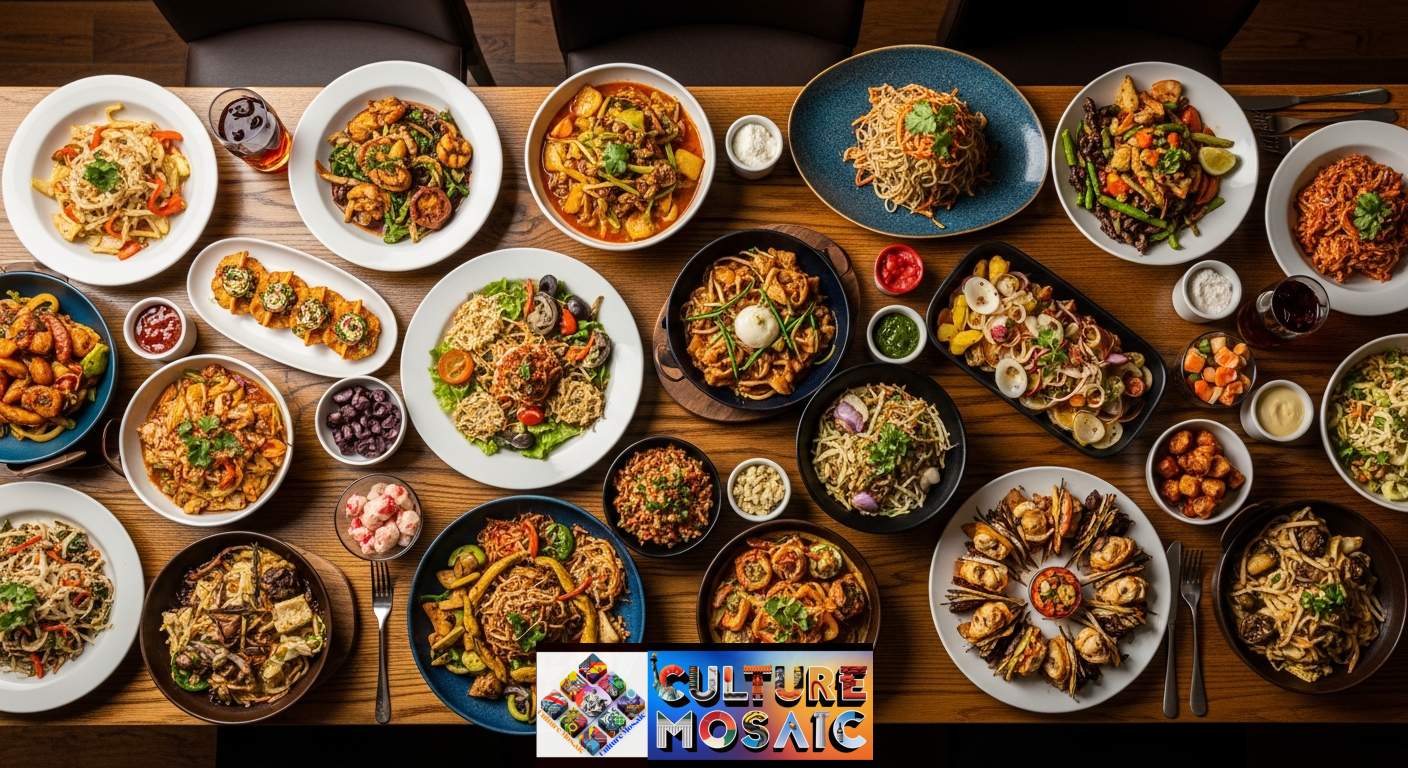Walk into any American city and you’ll see the evidence everywhere. Taquerias, pizzerias, pho shops, and curry houses—each one represents immigrant culinary traditions in America that transformed how we eat.
These aren’t just restaurants. They’re living archives of displacement, adaptation, and creativity. When immigrants arrived on American soil, they brought recipes that had been passed down for generations. Those recipes then evolved, shaped by new ingredients, different equipment, and the tastes of their new neighbors.
Understanding immigrant culinary traditions in the USA means understanding how food changes when it crosses borders. It’s about what happens when cooks can’t find the right ingredients, when they adapt to local palates, and when their children grow up eating both grandma’s cooking and school cafeteria lunches.
What Makes Immigrant Culinary Traditions in America Unique
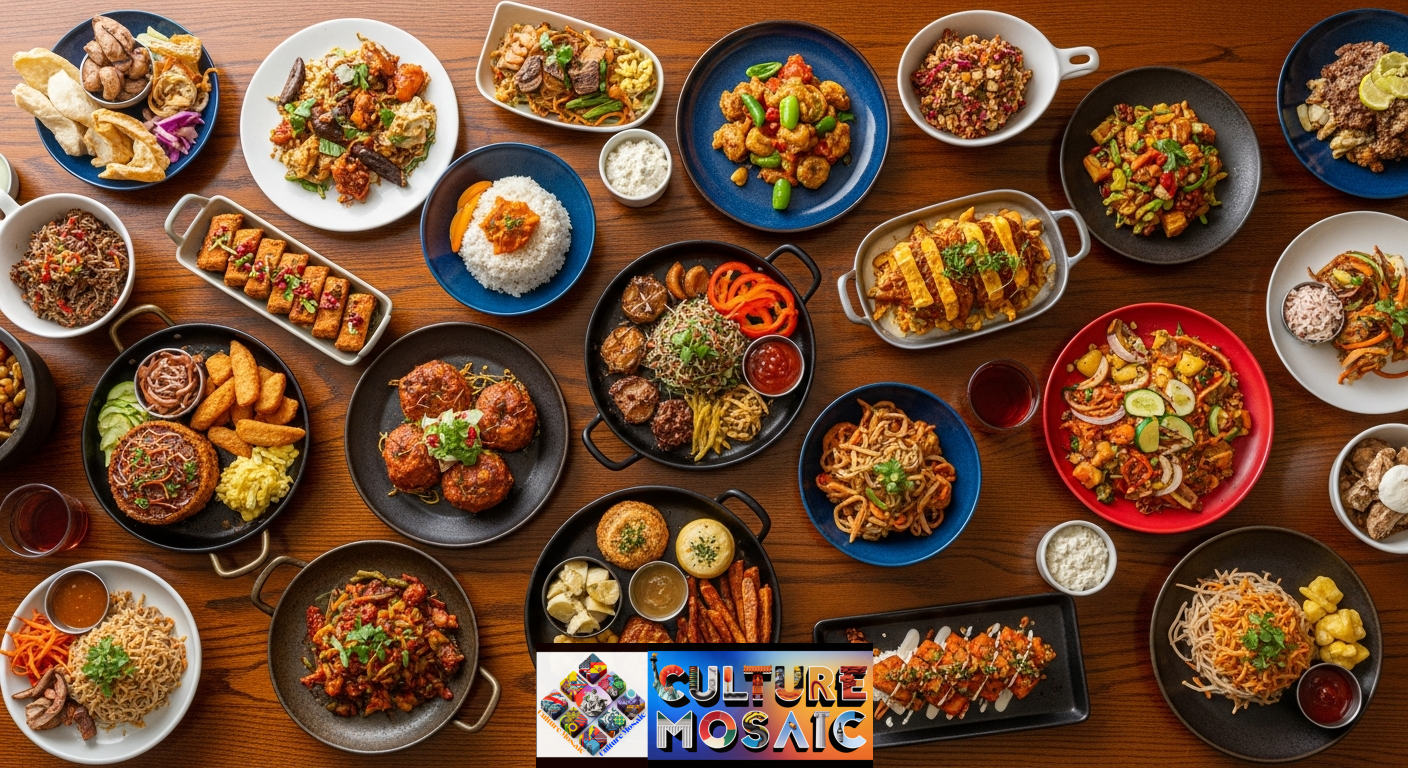
Immigrant culinary traditions in America follow a predictable pattern of transformation. First comes substitution—cooks replace unavailable ingredients with local alternatives. Then comes adaptation to American preferences. Finally, the next generation creates fusion without even trying.
This isn’t happening anywhere else at this scale. America’s unique immigration history means we have a more concentrated diversity of immigrant culinary traditions than perhaps any other place on earth. Mexican food from different regions, various Chinese regional cuisines, multiple African food traditions, countless European specialties—all coexisting and influencing each other.
What’s remarkable about immigrant culinary traditions in America is how they maintain authenticity while also evolving. A third-generation Italian-American grandmother making Sunday gravy is honoring tradition. So is a recent immigrant from Naples making traditional Neapolitan pizza. Both are legitimate expressions of immigrant culinary traditions in the USA.
Italian Immigrant Culinary Traditions in America: The Pizza Evolution

Italian immigrant culinary traditions in America started transforming the moment Italians arrived in New York in the late 1800s. They came mostly from southern regions where pizza was simple peasant food—thin crust, sparse toppings, local ingredients.
American conditions changed everything. The water was different, affecting the dough. The tomatoes tasted different. American ovens operated differently from wood-fired ones. And customers wanted something more substantial.
Italian immigrant culinary traditions in America evolved to meet these challenges. Pizza crusts got thicker and chewier. Cheese amounts increased dramatically. Toppings multiplied beyond anything seen in Naples. By mid-century, Italian-American pizza had become its own distinct cuisine.
The same transformation happened with pasta. In Italy, pasta was a small first course with light sauces. Italian immigrant culinary traditions in America turned it into a main dish—heaping plates with rich meat sauces, sometimes served alongside additional meat.
Sunday gravy—that slow-cooked tomato sauce loaded with meatballs, sausage, and braciole—is purely an Italian-American invention. It represents immigrant culinary traditions in America at their finest: rooted in Italian technique but shaped by American abundance.
Mexican Immigrant Culinary Traditions in America: Regional Diversity
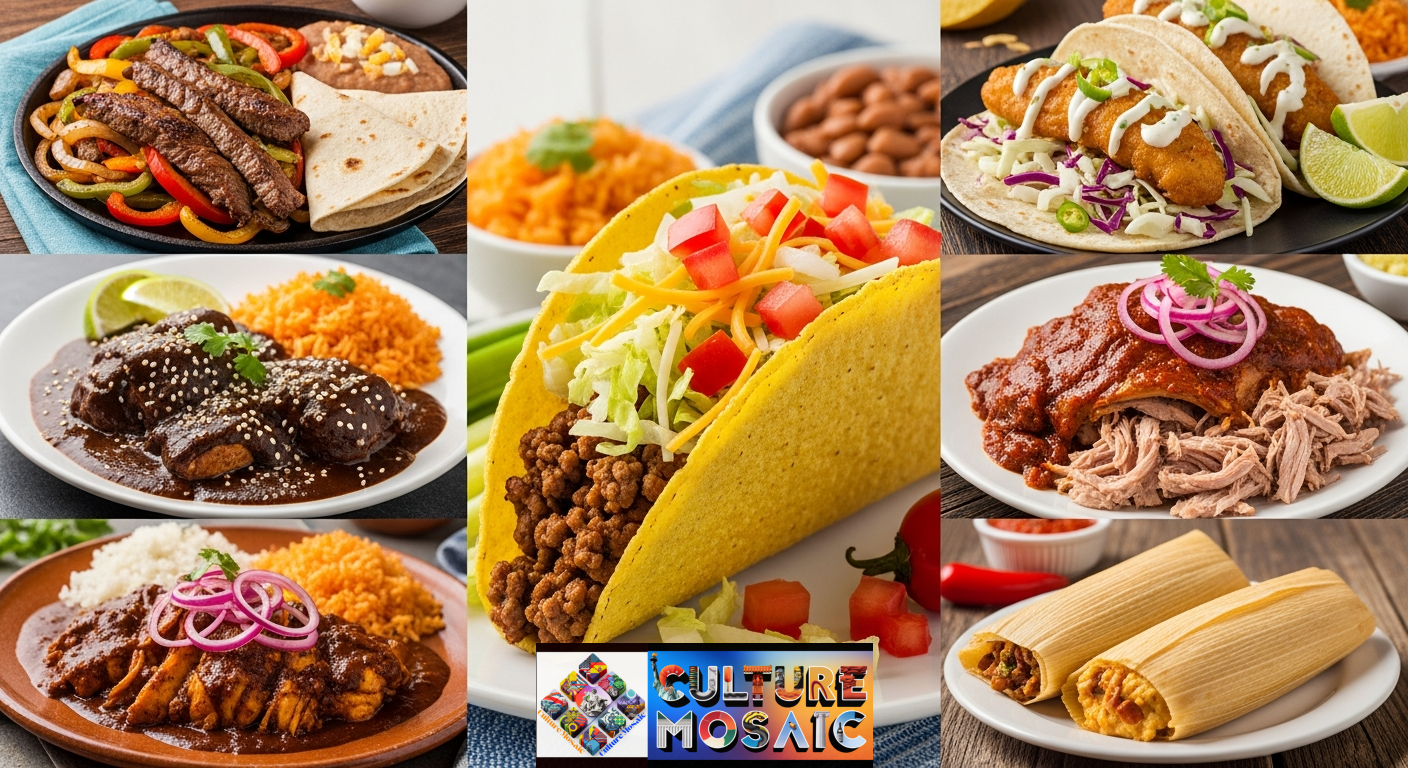
Mexican immigrant culinary traditions in America vary dramatically by region and era. The food Mexican-Americans eat in Texas differs from California, which differs from Chicago and New York. Each developed distinct characteristics based on local ingredients and immigrant populations.
The hard-shell taco exemplifies how immigrant culinary traditions in the USA evolve. In Mexico, tacos are served on soft corn tortillas with simple toppings. The U-shaped crispy shell filled with ground beef, lettuce, cheese, and tomato is an American creation, popularized for fast food production.
But Mexican immigrant culinary traditions in America aren’t just about Americanization. Authentic regional Mexican cooking continued flourishing in immigrant communities. Los Angeles, San Antonio, and Chicago developed rich Mexican-American food cultures that stayed closer to traditional preparations.
Starting in the 1980s, Mexican immigrant culinary traditions in the USA entered a new phase. Americans developed a serious interest in regional authenticity. Restaurants began specializing in Oaxacan food, Yucatecan specialties, or specific mole preparations. Food trucks brought regional dishes to new audiences.
This created space for Mexican immigrant culinary traditions in America to become both more authentic and more diverse. Chefs could cook traditionally while adapting to American dining expectations and ingredient availability.
Chinese Immigrant Culinary Traditions in America: The Longest Evolution
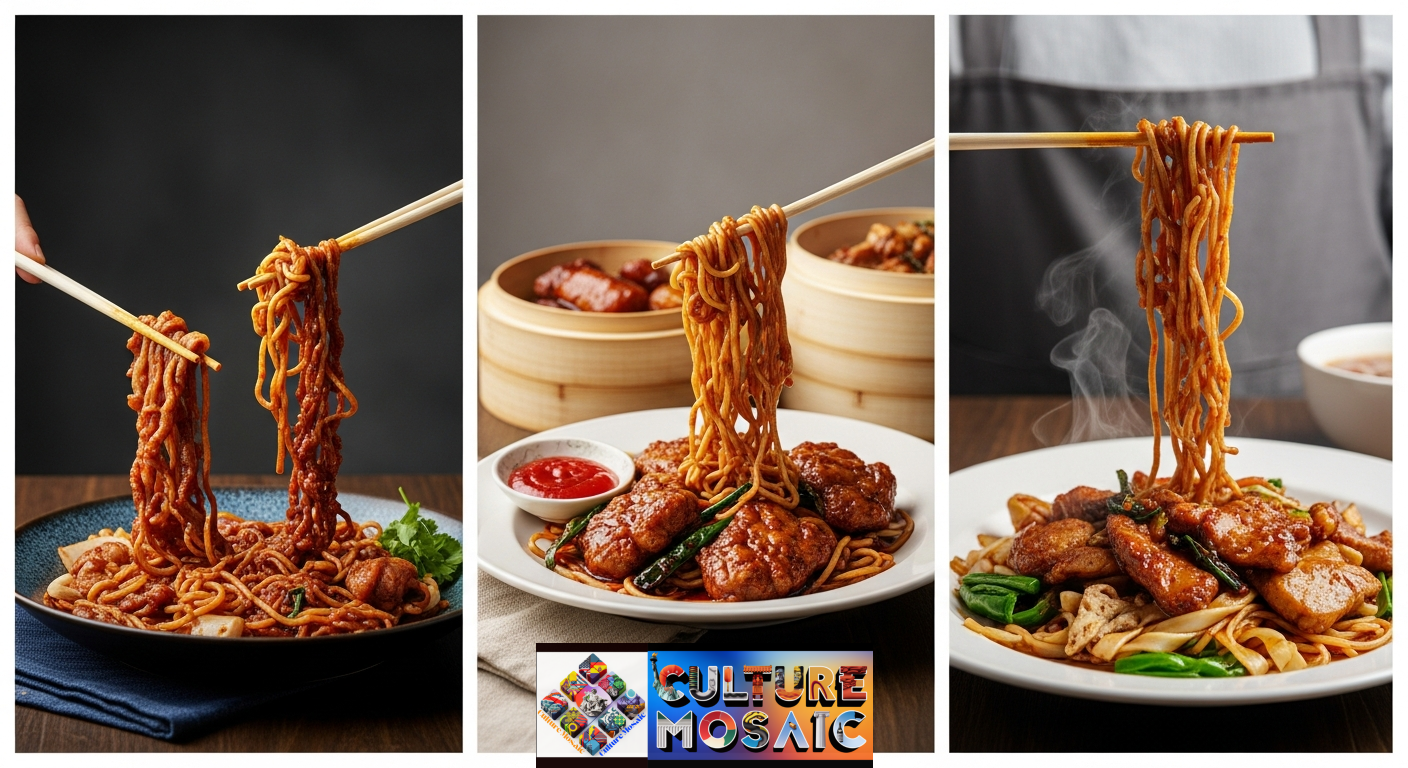
Chinese immigrant culinary traditions in America have the longest history, dating to the 1850s Gold Rush. This makes Chinese-American food one of the oldest adapted immigrant culinary traditions in the country.
Early Chinese immigrants faced extreme racism and limited access. Chinese immigrant culinary traditions in America developed through necessity—Cantonese cooks created Americanized dishes like chop suey to appeal to American diners while using available ingredients.
General Tso’s chicken shows how immigrant culinary traditions in the USA transform across multiple countries. Created by a Taiwanese chef in the 1950s, it was then adapted when he moved to New York in the 1970s. The American version became sweeter and heavier—adjusted specifically for American tastes.
But Chinese immigrant culinary traditions in America were never static. As immigration patterns shifted and brought people from different Chinese regions, the food diversified. Sichuan restaurants introduced numbing spice. Shanghai cooking brought soup dumplings. Cantonese dim sum became a weekend institution.
Today’s Chinese immigrant culinary traditions in America include both adapted classics like orange chicken and authentic regional specialties like hand-pulled Lanzhou noodles. Both coexist as legitimate expressions of Chinese food in America.
Vietnamese Immigrant Culinary Traditions in the USA: Maintaining Authenticity
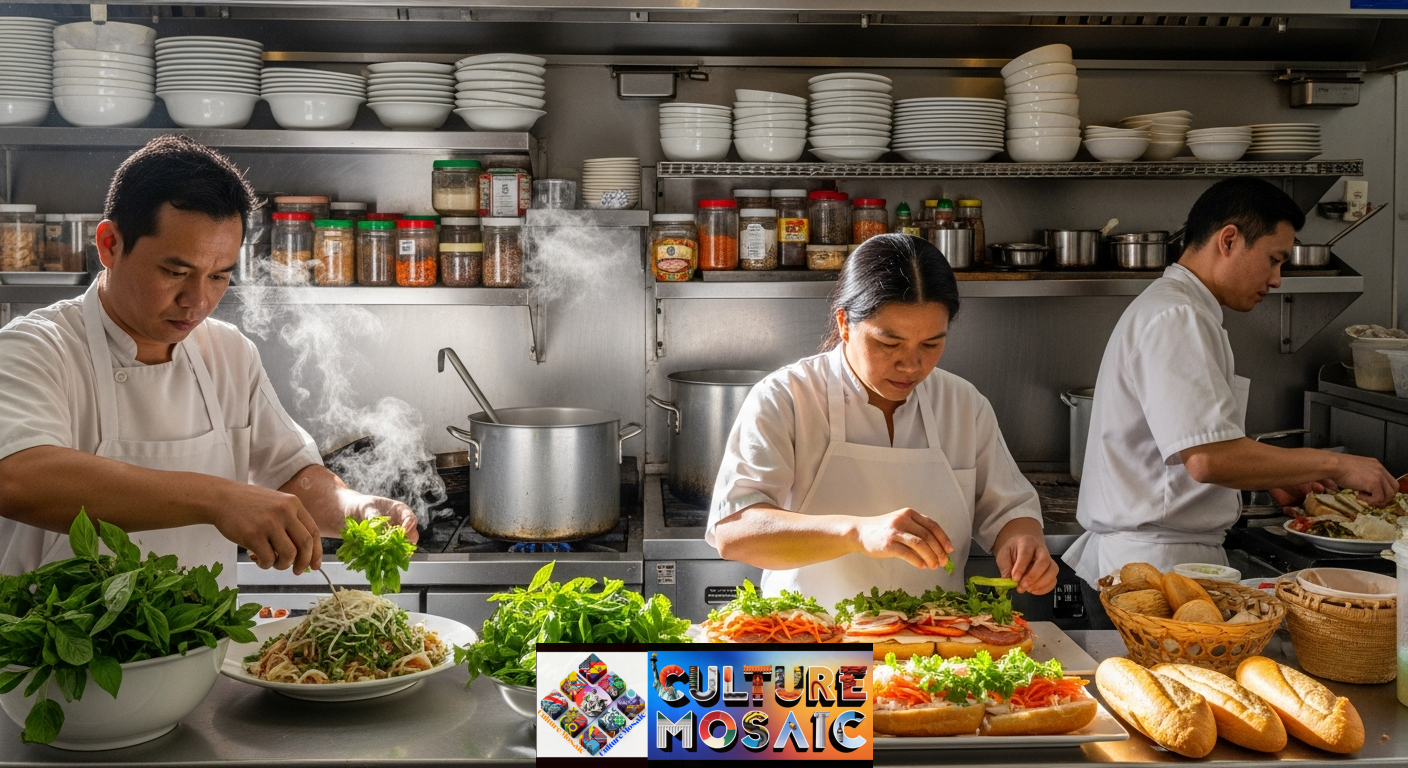
Vietnamese immigrant culinary traditions in America began with the refugee wave following the fall of Saigon in 1975. These refugees settled heavily in California, particularly Orange County, bringing pho, banh mi, and complex herb-based cooking.
What distinguishes Vietnamese immigrant culinary traditions in America is how closely they’ve maintained traditional preparations. Unlike Chinese or Italian food, Vietnamese cuisine hasn’t been heavily Americanized. Pho is still recognizably pho. Banh mi still uses proper technique.
Part of this relates to timing—Vietnamese immigrant culinary traditions in America emerged when Americans were more willing to accept authentic foreign flavors. Part relates to the community maintaining strong cultural ties and opening restaurants primarily for themselves initially.
Vietnamese immigrant culinary traditions in America have adapted to local ingredients and incorporated influences from neighboring communities (especially Mexican in Southern California), but the core techniques remain traditional.
Ethiopian Immigrant Culinary Traditions in America: Regional Concentration
Ethiopian immigrant culinary traditions in America are concentrated heavily in Washington, D.C., which has the largest Ethiopian population outside Africa. Along U Street and in the Virginia suburbs, dozens of restaurants serve injera-based meals with traditional spice blends.
These Ethiopian immigrant culinary traditions in the USA have influenced D.C.’s broader dining scene while remaining rooted in authentic preparation methods. The communal eating style, the complex spice combinations, the vegetarian options—all maintained despite being adapted for American diners.
Ethiopian immigrant culinary traditions in America show how regional concentration allows authentic cooking to flourish. When communities are large enough, restaurants can cook primarily for their own people rather than adapting heavily for mainstream American tastes.
Eastern European Immigrant Culinary Traditions in America: Midwest Preservation
Eastern European immigrant culinary traditions in America survive strongest in Midwestern cities like Cleveland, Chicago, and Detroit. Polish, Ukrainian, and Hungarian immigrants brought pierogi, kielbasa, borscht, and cabbage rolls.
These Eastern European immigrant culinary traditions in America get less attention than other cuisines, but remain vital to their communities. They’re maintained through cultural organizations, church groups, and families passing down recipes through generations.
Eastern European immigrant culinary traditions in America face challenges that more popular cuisines don’t. Fewer young people want to learn the techniques. Restaurant economics favor more mainstream cuisines. But dedicated cooks work to preserve these traditions.
How Immigrant Culinary Traditions in America Adapt to Local Ingredients
American ingredients fundamentally changed immigrant culinary traditions in America. Some ingredients became abundantly available that were scarce in the old country. Others were impossible to find, forcing substitution.
Meat availability transformed immigrant culinary traditions in the USA across nearly every cuisine. What was expensive overseas became affordable here. This explains why Italian-American food is meatier than Italian food, why Chinese-American dishes center on meat, and why Mexican-American portions grew larger.
Dairy products influenced immigrant culinary traditions in the USA significantly. American cheese appeared in dishes where it never existed traditionally. Sour cream became a standard Mexican-American topping. Cream-enriched curries beyond traditional Indian preparations.
Missing ingredients forced creative adaptation in immigrant culinary traditions in America. When specific chilies weren’t available, cooks used substitutes. When certain vegetables didn’t grow here, they adapted recipes. These substitutions became part of the American versions.
As food distribution improved, immigrant culinary traditions in America could circle back toward authenticity. Now, specialty ingredients are widely available, allowing cooks to prepare dishes closer to traditional methods while maintaining their American innovations.
Preserving Immigrant Culinary Traditions in America: The Heritage Keepers
While adaptation is natural, some chefs actively work to preserve pre-Americanized immigrant culinary traditions in the USA These heritage culinary traditions keepers serve crucial cultural functions.
Rick Bayless has spent decades documenting regional Mexican cuisine, studying immigrant culinary traditions in America, and their origins. His Chicago restaurants focus on authentic preparations rather than Tex-Mex adaptations.
Cristina Martinez in Philadelphia makes traditional barbacoa using methods her family used in Mexico—immigrant culinary traditions in America are maintained despite legal and regulatory challenges. The traditional clay pit method matters to the final dish.
These chefs understand that immigrant culinary traditions in the USA need both adaptation and preservation. Adapted versions make unfamiliar food accessible. Traditional versions maintain cultural knowledge and give later generations a connection to their heritage.
Learning Techniques from Immigrant Culinary Traditions in America
Understanding immigrant culinary traditions in America means learning fundamental techniques that define each cuisine.
- Italian Immigrant Culinary Traditions: Sunday Gravy. The foundation of Italian immigrant culinary traditions in the USA is slow-cooked tomato sauce. Start with quality canned tomatoes. Sauté garlic gently in olive oil. Add crushed tomatoes with salt and a pinch of sugar. Simmer at least two hours, adding browned meatballs and sausages. Long cooking develops the depth characteristic of Italian immigrant culinary traditions in America.
- Mexican Immigrant Culinary Traditions: Working with Dried Chile. Mexican immigrant culinary traditions in the USA rely on properly prepared dried chilies. Toast them lightly until fragrant, soak to rehydrate, then blend with aromatics. Different chilies bring different flavors—ancho is sweet, guajillo is tangy, chipotle is smoky. Mastering chilies unlocks authentic Mexican immigrant culinary traditions in America.
- Chinese Immigrant Culinary Traditions: Wok Technique. Chinese immigrant culinary traditions in the USA depend on intense heat and quick cooking. Get your wok smoking hot before adding oil. Work in small batches so ingredients sear rather than steam. Keep everything moving. This technique, called wok hei, is fundamental to Chinese immigrant culinary traditions in America.
- Vietnamese Immigrant Culinary Traditions: Building Broth Vietnamese immigrant culinary traditions in America center on proper broth technique. Char onions and ginger over flame until blackened. Simmer beef bones for hours—minimum six, ideally twelve. Toast spices before adding. Skim continuously. The resulting broth should be clear, complex, and deeply flavored.
The Next Generation of Immigrant Culinary Traditions in America
Children and grandchildren of immigrants are creating new expressions of immigrant culinary traditions in America—food rooted in heritage but unbound by strict authenticity.
Roy Choi’s Kogi BBQ represents the future of immigrant culinary traditions in the USA. His Korean-Mexican fusion isn’t confusing—it’s authentic to growing up in Los Angeles with both Korean and Mexican immigrant culinary traditions in America existing side by side.
These chefs aren’t trying to replicate any single tradition. They’re authentic to their own multicultural experience. This is where immigrant culinary traditions in the USA are heading—not just preservation or adaptation, but confident synthesis of multiple influences.
Why Immigrant Culinary Traditions in America Matter Beyond Food
Immigrant culinary traditions in America carry stories of displacement, adaptation, and community building. When Vietnamese refugees arrived with nothing, pho restaurants became economic foundations. When Italian immigrants faced discrimination, their restaurants maintained cultural identity. When Mexican workers couldn’t afford restaurants, taco trucks eventually changed American food culture.
Immigrant culinary traditions in America preserve cultural knowledge. Cooking techniques passed through generations maintain a connection to heritage. They give later generations ways to understand their backgrounds. They create economic opportunities for new arrivals.
Immigrant culinary traditions in the USA make our food culture vastly more interesting. Without them, American cuisine would be dramatically impoverished. The best American food is hybrid—taking knowledge from elsewhere and transforming it here.
Finding Authentic Immigrant Culinary Traditions in America
To experience immigrant culinary traditions in America beyond Americanized versions, look for restaurants in ethnic neighborhoods rather than downtown districts. Places serving immigrant communities cook more traditionally than those targeting general audiences.
Check who’s eating there. If restaurants are full of people from that culture, they’re choosing food that tastes like home—authentic immigrant culinary traditions in the USA.
Order what you see other tables eating. Unfamiliar dishes are often the most traditional expressions of immigrant culinary traditions in America.
Follow immigrant food bloggers who share where to find authentic versions of immigrant culinary traditions in the USA in their areas.
The Living Evolution of Immigrant Culinary Traditions in the USA
Immigrant culinary traditions in America aren’t frozen in time. They’re living practices that change with each generation while maintaining continuity threads.
The Italian-American red sauce restaurant and the modern Neapolitan pizzeria both authentically represent immigrant culinary traditions in the USA—one showing Italian-American experience, one showing current Italian traditions. The Tex-Mex combination plate and the Oaxacan tlayuda both legitimately express Mexican immigrant culinary traditions in America.
Understanding immigrant culinary traditions in the USA requires letting go of rigid authenticity ideas. Food changes. Recipes adapt. Techniques evolve. This has always happened everywhere. Immigration just accelerates the process.
What makes immigrant culinary traditions in America special is the speed and scale. Nowhere else has this concentration of global food traditions, all adapting simultaneously, all influencing each other, all being sampled by adventurous eaters.
The result is the world’s most diverse, dynamic food culture. Not because American food is inherently superior, but because immigrant culinary traditions in the USA are inherently plural—built from contributions of people who came from elsewhere and made something new here.
Every time you eat tacos, pizza, pho, or curry, you’re participating in this ongoing story of immigrant culinary traditions in America. You’re eating the edible archive of human migration and creativity. That’s worth savoring.
Frequently Asked Questions
What are the most influential immigrant culinary traditions in America?
The most influential immigrant culinary traditions in America are Italian, Mexican, and Chinese cuisines, which have deeply shaped mainstream American eating. Italian immigrant culinary traditions brought pizza and pasta that became national staples. Mexican immigrant culinary traditions influence everything from fast food to fine dining. Chinese immigrant culinary traditions USA are found in nearly every American town. More recently, Vietnamese, Thai, Indian, Ethiopian, and Korean immigrant culinary traditions USA have gained significant urban influence.
Why do immigrant culinary traditions in the USA taste different than food in the home country?
Immigrant culinary traditions in America taste different due to several factors. Available ingredients differ—certain spices or proteins may be unavailable. American taste preferences often favor sweeter, richer, or less spicy food than traditional versions. Portion sizes in immigrant culinary traditions in the USA tend to be larger. Cooking methods may change due to different equipment or regulations. These adaptations don’t make immigrant culinary traditions in America inauthentic—they create new legitimate regional cuisines like Italian-American or Tex-Mex.
How can I find authentic immigrant culinary traditions in the USA in my area?
To find authentic immigrant culinary traditions in the USA, look for restaurants in neighborhoods with significant immigrant populations rather than tourist areas. Check if clientele includes many people from that culture—they’re eating immigrant culinary traditions in America that remind them of home. Order dishes you see on other tables rather than only familiar items. Follow food bloggers from specific cultures who share recommendations for authentic immigrant culinary traditions in America. Don’t worry about partially translated menus—that’s often a sign of authenticity.
Are Americanized versions of immigrant culinary traditions in America considered authentic?
Americanized versions are authentic expressions of immigrant culinary traditions in the USA, even if they differ from food in the home country. Italian-American, Chinese-American, and Tex-Mex are legitimate regional immigrant culinary traditions in America created by immigrants adapting to new circumstances. They represent real cultural evolution. Both Americanized and traditional versions can coexist as authentic immigrant culinary traditions in America—one showing adaptation, the other preservation.
How do second and third-generation immigrants approach their family’s culinary traditions?
Second and third-generation immigrants have complex relationships with immigrant culinary traditions in America from their heritage. Some preserve traditional recipes exactly as grandparents made them. Others create fusion dishes blending their family’s immigrant culinary traditions the USA with other influences from growing up in multicultural environments. Many switch between modes—cooking traditionally at family gatherings and experimentally in their own kitchens. This generation drives innovation in immigrant culinary traditions in the USA by confidently combining influences without worrying about rigid authenticity.

